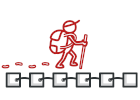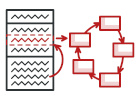Behavioral Design Patterns
Behavioral design patterns are concerned with algorithms and the assignment of responsibilities between objects.
Lets you pass requests along a chain of handlers. Upon receiving a request, each handler decides either to process the request or to pass it to the next handler in the chain.
Turns a request into a stand-alone object that contains all information about the request. This transformation lets you parameterize methods with different requests, delay or queue a request’s execution, and support undoable operations.
Lets you traverse elements of a collection without exposing its underlying representation (list, stack, tree, etc.).
Lets you reduce chaotic dependencies between objects. The pattern restricts direct communications between the objects and forces them to collaborate only via a mediator object.
Lets you save and restore the previous state of an object without revealing the details of its implementation.
Lets you define a subscription mechanism to notify multiple objects about any events that happen to the object they’re observing.
Lets an object alter its behavior when its internal state changes. It appears as if the object changed its class.
Lets you define a family of algorithms, put each of them into a separate class, and make their objects interchangeable.
Defines the skeleton of an algorithm in the superclass but lets subclasses override specific steps of the algorithm without changing its structure.
Lets you separate algorithms from the objects on which they operate.
 Chain of Responsibility
Chain of Responsibility Command
Command Iterator
Iterator Mediator
Mediator Memento
Memento Observer
Observer State
State Strategy
Strategy Template Method
Template Method Visitor
Visitor